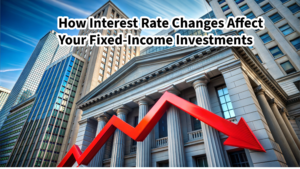
How Interest Rate Changes Affect Your Fixed-Income Investments
Interest rates play a pivotal role in the performance of fixed-income investments. Understanding this relationship helps investors navigate market fluctuations and make informed financial decisions.
1. What Are Interest Rates and How Are They Set?
- Definition: The cost of borrowing money or the return earned on savings.
- Determining Factors:
- Set by the Reserve Bank of India (RBI) through monetary policy.
- Influenced by inflation, economic growth, and global market conditions.
Example:
If the RBI increases the repo rate, borrowing becomes expensive, impacting both businesses and consumers.
2. Fixed-Income Investments Most Impacted by Interest Rates
- Government Bonds.
- Corporate Bonds.
- Fixed Deposits (FDs).
- Fixed-Income Mutual Funds.
Why?
The yield of these instruments adjusts to reflect prevailing interest rates, affecting both income and value.
3. The Inverse Relationship Between Interest Rates and Bond Prices
How It Works:
- When interest rates rise, bond prices fall.
- When interest rates fall, bond prices rise.
Reason:
Bonds with higher fixed coupon rates become less attractive when newer bonds offer better yields.
Example:
- A bond with a 7% coupon becomes less valuable if new bonds offer 8%.
4. Impact on Various Fixed-Income Instruments
A. Fixed Deposits (FDs):
- New FDs offer higher interest rates during rate hikes.
- Existing FDs remain unaffected.
B. Bonds:
- Long-term bonds are more sensitive to interest rate changes than short-term bonds.
- Example: A 20-year bond will fluctuate more in price compared to a 2-year bond.
C. Fixed-Income Mutual Funds:
- Duration-based funds (long-term debt funds) are highly impacted.
- Short-term debt funds are relatively stable.
5. Strategies to Manage Interest Rate Risks
A. Ladder Your Investments:
- Divide investments across various maturities to balance risk and returns.
- Example: Invest in FDs of 1-year, 3-year, and 5-year tenures.
B. Prefer Shorter Durations During Rate Hikes:
- Invest in short-term bonds or funds that are less sensitive to interest rate changes.
C. Monitor the Yield Curve:
- A flattening or inverted curve indicates potential changes in interest rates.
D. Opt for Floating Rate Bonds:
- These adjust payouts based on prevailing interest rates, protecting your income.
6. Why Duration Matters in Bonds
Duration: A measure of a bond’s sensitivity to interest rate changes.
- High Duration: Greater sensitivity to interest rates (long-term bonds).
- Low Duration: Less sensitivity (short-term bonds).
Example:
A bond with a duration of 5 years will lose approximately 5% in value if interest rates rise by 1%.
7. Economic Indicators Signaling Rate Changes
A. Inflation:
- Rising inflation often leads to rate hikes to control prices.
B. GDP Growth:
- High growth might prompt rate increases to prevent overheating.
C. RBI Announcements:
- Bi-monthly monetary policy reviews offer hints about rate changes.
8. Case Study: Navigating Interest Rate Changes
Scenario:
An investor holds a ₹10 lakh portfolio:
- ₹5 lakh in a 10-year government bond.
- ₹3 lakh in a short-term debt fund.
- ₹2 lakh in FDs.
Interest Rate Rise:
- Long-term bonds lose value (~5%).
- Short-term funds are less impacted.
- New FDs offer higher rates, presenting reinvestment opportunities.
Outcome: A balanced portfolio reduces overall risk.
9. FAQs on Interest Rates and Investments
Q1. Are corporate bonds safer during rising rates?
- Safer bonds (AAA-rated) still face price impacts but offer higher coupon rates to compensate.
Q2. Should I withdraw long-term investments during a rate hike?
- No, long-term investments recover value if held to maturity.
Q3. Are debt mutual funds better than FDs in rising interest rate scenarios?
- Short-duration funds or dynamic bond funds may be better, offering flexibility to adjust to rate changes.
10. Conclusion
Interest rate movements have a profound impact on fixed-income investments, particularly bonds and debt funds. By understanding these dynamics and adopting strategies like diversification, laddering, and monitoring the yield curve, investors can optimize returns and mitigate risks effectively.